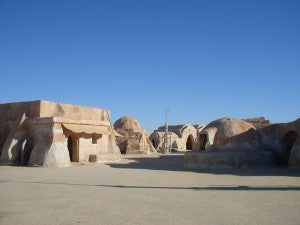Star Wars Awakens Much-Needed Energy-Water Innovation
 Originally published on CleanTechnica.
Originally published on CleanTechnica.
I was a little kid when the first Star Wars movie came out, and it’s not an understatement to say that it remains a huge influence on me. For those of my generation, growing up in the 1980s, it was a powerful “force” in our lives. The Star Wars films have arguably left a legacy like no other: in the 2011 census, nearly 200,000 residents of England and Wales identified themselves as Jedi Knights, the largest single category after the traditional, mainstream religions. And now, with the new film promising to restore fans’ faith in the franchise, a new generation can be inspired.
But aside from its devoted fan base, Star Wars and other sci-fi mega-blockbusters have a much greater role to play in our society. Science fiction both reflects the times we are in and inspires future technologies – not to mention the innovators that create them. This is true of most science fiction: think about Jules Verne (arguably the father of Science Fiction) and the influence 20,000 Leagues Under the Sea had on submarines, or the original Star Trek series and communicators (flip phones), or 2001: A Space Odyssey and interactive computers (hello, Siri!).
Science and technology is at the forefront of the Star Wars movies as well, and the energy and water technologies featured in the films have influenced research and development today. As the effects of climate change alter our planetary conditions more and more, innovative technology that helps us take better command over our resources will be invaluable. And who wouldn’t be inspired by Star Wars when one of the units for measuring electrical, mechanical, and thermal energy is called a Yottajoule (pronounced like “Yoda-joule”)?
The energy of Star Wars
One could argue that energy is a major theme of Star Wars, in the Force itself. As Obi-Wan Kenobi explains it:
“Well, the Force is what gives a Jedi his power. It’s an energy field created by all living things. It surrounds us, penetrates us; it binds the galaxy together.”
In a sense, the Star Wars universe shows us a place and time where power and materials are not really an issue. From landspeeders, Luke’s main mode of transportation (in the original, Luke has a hard time unloading his X-34 because the newer model, the XP-38, makes his nearly obsolete – and his still looks cool to our eyes), to the power generator on the planet Hoth (probably some sort of fusion reactor), to a plug-in droid like R2D2 (most likely very energy-intensive), the unspoken premise relies on the management of available energy resources.
[Tweet “Star Wars awakens much-needed energy-water innovation. #cleanenergynow”]
So, as we face a future with harsher climate conditions, how do we better utilize the resources we have in the environment we’re in? That’s essentially what building a smarter electric grid is all about, which will allow homes and businesses to use, as well as produce and sell, electricity in a more technologically advanced, clean, and efficient way.
And more specific to Star Wars, researchers today are creating technologies to make smaller, more efficient space craft, nuclear power similar to that of Hoth’s generator (for space travel and other uses), and droids like R2D2 and C3PO. For example, the landspeeder could be said to be an inspiration for the Japanese maglev train, which runs on a track using electrically-charged magnets rather than power lines, “floating” and cutting travel time in half. But, in my opinion, the most exciting influence of Star Wars can be seen in up-and-coming water technology.
The water of Star Wars
When you think about Star Wars and water, the first thing that comes to mind is how Luke Skywalker and his Uncle Owen are “moisture farmers” on the desert planet of Tattoine. They extract water from the air with a technology known as a “moisture vaporator.”
Technology that captures water from the air is actually being developed today, along with other advanced water technologies that address the energy-water nexus, or the inextricable link between energy and water. Specifically, scientists today are trying to figure out if we would be able to farm water on Mars with a similar technology, and scientists in the Atacama Desert in Chile (the driest in the world) are testing fog catchers as a way to farm the water in the air. Another innovative solution to quenching thirst in the desert comes in the form of the WaterDrop, a handheld solar-powered device that uses the sun and an atmospheric water condenser to create condensation for drinking.
Undoubtedly, we will live in a future world where water is even more valuable than it is now. According to the World Resources Institute, 33 countries are expected to face extreme water stress by 2040. These technologies, inspired by the Star Wars universe, could help us figure out how to survive in increasingly dry conditions as climate change advances.
The mythmaking of Star Wars
Star Wars is of course science fiction, but it, and its genre cohorts, inspires innovators and philosophers to find solutions and new ways of doing things in our world. These movies are the ultimate space cowboy epics—they appeal to that frontier, can-do spirit that is also part of the culture in places like Texas and California, where we see many of these technologies being developed. That spirit is essential to tackling the great climate obstacles we currently are facing.
In the end, these stories and myths matter to us. Luke is a classic mythical hero, and his story resonates with us on a very human level. They are speculative, inspiring, and push us to think about our world in a different way. Star Wars and its cohorts help us come up with solutions to current and future problems, and this kind of inventive thinking will increasingly be needed as we face the impacts of climate change.
May the Force be with us, always.










